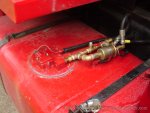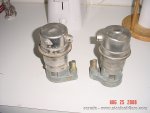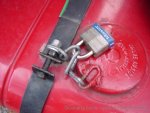SasquatchSanta
New member
- 1,177
- 18
- 0
- Location
- Northern Minnesota
Over the past few months, after having trouble with my original in-tank fuel pump I've been going back and forth between running stock in-tank pumps and OD Iron's in-line pump. I'm sharing this so you may gain some insight from my experiences.
First ... I suspect that I was also having fuel jelling problems when my original in-tank pump failed. I'm not saying the jelling problems caused the pump failure, only that it seemed to happen at the wame time. When the first pump failure happened the truck was idling, warming up in my drive way on a below zero morning in January. What got my attention that something was wrong was when the engine shuttered and died. I guess that's a pretty sure sign that there is a problem.
Figuring if it died once, it would probably die again and the next time it wouldn't be in my driveway I decided to address the problem when the snow was gone. I've since learned that once the engine is running the IP booster pump will pull fuel from the tank and keep the engine running. I should note that I read in a TM that the in-tank pump is needed during operation to supply positive pressure to the boster pump. (my words, not the TMs). Sooo ... what this all means is that I probably had a fuel jell problem AND a pump failure at the same time.
I purchased one of OD Iron's in-line "thumper" pumps. Everything went fine until I decided to get cute and remove the in-tank pump and install a 1/2" pickup tube in it's place. I removed the stock in-tank pump because at the time I didn't know if it was causing restrictions that could possibly overwork the OD Iron pump. As it happened, removing the original pump and the therefore it's screen was a big mistake. The tube that replaced the pump did not have a screen and there lies the problem. I should note that I later learned that the original in-tank pump does NOT cause a restriction on the OD Iron in-line piump.
A few weeks later I was tooling down I-494 in Minneapolis during rush hour traffic with an 18 foot trailer in tow and the engine suddenly died. This is everyone's nightmare. Over the roar of traffic could hear the thumper pump doing it's thing so I cracked open the petcock on the spin-on primary fuel filter. Very little fuel came out. I sprayed myself down with mosquito repellent and proceeded to changed the filter. With the new filter still very little fuel came out of the petcock. Stored under the drivers seat, beside the spare fuel was also a spare in-line pump. I installed the new pump and within 30 minuted was underway.
Needless to say, the trip back to the boarder was a white knuckle affair. All I could think was, if that thumper pump quit once the new one could also quit and I'm out of spares. Once again, just like when the original pump quit working last winter, it didn't make sense that the ending died but, once again, it did.
When I arrived home emailed Mike at OD Iron. He responded immediately and offered to replace the pump on a no-charge basis. I declined because I wasn't sure my problem was the fault of the pump. I TAKE MY HAT OFF TO MIKE for offering to replace the pump BUT I've been around long enough to know that it isn't always the vendor's fault.
My old friend Honest John Bizal of Midwest Military said he had a stock pump that he thought was good and sent it to me for a try. He didn't invoice me so I was going to see if it was a good pump. I finally got around to installing it but before I did I installed a fuel pressure gauge between the primary filter and the IP booster pump. It was no doubt overkill but after having the Minneapolis freeway experience I wanted some backup so we installed the in-tank pump in parallel with the OD Iron pump. If one went out all I had to do is to turn a valve and swap fuses and I had the OD Iron pump to fall back on.
Both the in-tank pump and the thumper pump generate around 6 PSI of pressure --- that was until yesterday when I noticed that the in-tank pump's pressure was dropping. In a 40 mile round trip it dropped from 6 PSI to 1 PSI. When I got home I noticed the in-tank pump sounded like it was running rough. Not knowing if the low pressure was a fuel filter problem I quickly switched over to the thumper pump (see attached picture). The fuel pressure shot up to 6 PSI --- obviously not a fuel filter problem. Looks like ANOTHER in-tank pump bites the dust.
ANOTHER DEVELOPMENT --- I cut into the original OD Iron pump that failed on the Minneapolis freeway and found 6 small pieces of dried gasket material that looked like mouse turds lodged in the outlet orifice that were plugging the pump. These came from material materiel in the bolt holes being pushed into the tank when the round cover plate was installed
As previously stated, I had removed the original pump and it's screen and had not installed a replacement screen. This was a BIG MISTAKE. Considering what was lodged in the outlet orifice I'm surpriced the engine ran as long as it did.
Now that I know what caused the OD Iron pump failure --- that it was "operator error" and not the fault of the pump I'm going to quit monkeying around with intank pumps.
I'm also installing a second fuel pressure gauge --- the second one between the pump and the primary filter. With a gauge before and after the primary filter I'll know when if I have a fuel filter problem OR a pump problem.
First ... I suspect that I was also having fuel jelling problems when my original in-tank pump failed. I'm not saying the jelling problems caused the pump failure, only that it seemed to happen at the wame time. When the first pump failure happened the truck was idling, warming up in my drive way on a below zero morning in January. What got my attention that something was wrong was when the engine shuttered and died. I guess that's a pretty sure sign that there is a problem.
Figuring if it died once, it would probably die again and the next time it wouldn't be in my driveway I decided to address the problem when the snow was gone. I've since learned that once the engine is running the IP booster pump will pull fuel from the tank and keep the engine running. I should note that I read in a TM that the in-tank pump is needed during operation to supply positive pressure to the boster pump. (my words, not the TMs). Sooo ... what this all means is that I probably had a fuel jell problem AND a pump failure at the same time.
I purchased one of OD Iron's in-line "thumper" pumps. Everything went fine until I decided to get cute and remove the in-tank pump and install a 1/2" pickup tube in it's place. I removed the stock in-tank pump because at the time I didn't know if it was causing restrictions that could possibly overwork the OD Iron pump. As it happened, removing the original pump and the therefore it's screen was a big mistake. The tube that replaced the pump did not have a screen and there lies the problem. I should note that I later learned that the original in-tank pump does NOT cause a restriction on the OD Iron in-line piump.
A few weeks later I was tooling down I-494 in Minneapolis during rush hour traffic with an 18 foot trailer in tow and the engine suddenly died. This is everyone's nightmare. Over the roar of traffic could hear the thumper pump doing it's thing so I cracked open the petcock on the spin-on primary fuel filter. Very little fuel came out. I sprayed myself down with mosquito repellent and proceeded to changed the filter. With the new filter still very little fuel came out of the petcock. Stored under the drivers seat, beside the spare fuel was also a spare in-line pump. I installed the new pump and within 30 minuted was underway.
Needless to say, the trip back to the boarder was a white knuckle affair. All I could think was, if that thumper pump quit once the new one could also quit and I'm out of spares. Once again, just like when the original pump quit working last winter, it didn't make sense that the ending died but, once again, it did.
When I arrived home emailed Mike at OD Iron. He responded immediately and offered to replace the pump on a no-charge basis. I declined because I wasn't sure my problem was the fault of the pump. I TAKE MY HAT OFF TO MIKE for offering to replace the pump BUT I've been around long enough to know that it isn't always the vendor's fault.
My old friend Honest John Bizal of Midwest Military said he had a stock pump that he thought was good and sent it to me for a try. He didn't invoice me so I was going to see if it was a good pump. I finally got around to installing it but before I did I installed a fuel pressure gauge between the primary filter and the IP booster pump. It was no doubt overkill but after having the Minneapolis freeway experience I wanted some backup so we installed the in-tank pump in parallel with the OD Iron pump. If one went out all I had to do is to turn a valve and swap fuses and I had the OD Iron pump to fall back on.
Both the in-tank pump and the thumper pump generate around 6 PSI of pressure --- that was until yesterday when I noticed that the in-tank pump's pressure was dropping. In a 40 mile round trip it dropped from 6 PSI to 1 PSI. When I got home I noticed the in-tank pump sounded like it was running rough. Not knowing if the low pressure was a fuel filter problem I quickly switched over to the thumper pump (see attached picture). The fuel pressure shot up to 6 PSI --- obviously not a fuel filter problem. Looks like ANOTHER in-tank pump bites the dust.
ANOTHER DEVELOPMENT --- I cut into the original OD Iron pump that failed on the Minneapolis freeway and found 6 small pieces of dried gasket material that looked like mouse turds lodged in the outlet orifice that were plugging the pump. These came from material materiel in the bolt holes being pushed into the tank when the round cover plate was installed
As previously stated, I had removed the original pump and it's screen and had not installed a replacement screen. This was a BIG MISTAKE. Considering what was lodged in the outlet orifice I'm surpriced the engine ran as long as it did.
Now that I know what caused the OD Iron pump failure --- that it was "operator error" and not the fault of the pump I'm going to quit monkeying around with intank pumps.
I'm also installing a second fuel pressure gauge --- the second one between the pump and the primary filter. With a gauge before and after the primary filter I'll know when if I have a fuel filter problem OR a pump problem.
Attachments
-
106.7 KB Views: 609







